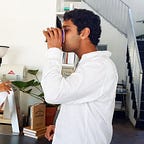Unexpected: coffee was first grown beside the Arabian Desert??
I just discovered something I wasn’t quite expecting:
that on the edge of the vast dry expanse called the Arabian Desert, where wind blown rivers of sandy irony drown the parched land in the yellow of the scorching sun, our tropical water hungry friend, coffee, was first cultivated — in the mountains of Yemen!
These mountains rise to over 3000m, towering over the Red Sea and for a few months every year, torrents of humid sea air are driven up their sides cooling and falling as rain. This precious water is captured by carefully manicured, and totally stunning, terraces where coffee will grow through the dry season at unheard of elevations of 2400m. The most striking aspect to me, is not only that coffee grows like this nowhere else on earth, it is that this is in fact the original setting, the original romance and imagery of the mystical bean.
And it was in mysticism that it’s vitalizing effects were first discovered and made into the beverage we know today. According to the Abd-Al-Kadir manuscript the myth goes thus: Sheik Omar, a Yemeni doctor-priest from Mocha, Yemen, known to heal the sick through prayer, was exiled to a desert cave near Ousab. In exile he came close to starvation and cried out in despair when a bird came down with a branch of coffee cherries. He tried to eat them raw, but found them bitter. So he threw them into a fire, a found them hard. Eventually, he put these roasted beans into boiling water to soften them and noticed the fine aroma developing and characteristic brown colour. Upon drinking it he found vitalisation which sustained him through the rest of his exile. News quickly got out of his discovery and when it reached Mocha, his exile was lifted. Upon returning to Mocha, he shed the beans, the drink and saw that it ‘cured’ many ailments (2)
And from these mysterious beginnings came the coffee bean native to Yemen, the Mocha bean. As early as the 15th century it enchanted Sufi mystics of Yemeni monasteries, these are where the first substantiated claims of the use of the drink we know today. However, cultivation may stretch back as early as the 10th century in Yemen. The beans arriving through trade from the nearby country, where coffee grows wild in the forests, Ethiopia (4).
The Mocha bean went on to enchant everyone from the Europeans to the Javanese with it’s distinct aroma, acidity and chocolate depth. Mocha itself grew rich as it uniquely exported coffee to the world, the bean was precious and always roasted before export to prevent propagation. Interestingly, this is also the origin of the famous Mocha-Java coffee blend, the first blended coffee ever.
As such, the traditions of coffee roasting and preparation methods run deep in Yemeni culture. Friends still gather, patiently journeying with each step of the preparation process, observing a moment that dwells at the heart of coffee culture.
One thing I personally love, is that the heat and dry weather allows farmers to sun dry the red coffee cherries before removing the bean. In more tropical climates where the majority of coffee is grown, it’s too humid to sun dry and the beans are immediately washed of their cherries. In Yemen, as the cherry dries it imparts it’s sweetness, fruity acidity and complexity. You can really taste this in the final product.
Today, this magnificent coffee is hard to find due to the hardships facing Yemen, namely war and famine. I can only imagine that by purchasing a cup yourself, you’re not only helping a farmer through tough times but also capturing a moment of history and keeping it alive. There is a real threat to Yemeni coffee as the reduction in exports has pushed many farmers into farming Khat, a fast growing drug, which requires huge quantities of water and chemicals, thus, destroying these carefully preserved terraces (7). What’s more is that the remaining farmers are pressured into growing high yield low quality coffee varieties, rather than the elegant Mocha bean. There are a couple of places in London I’d recommend grabbing a true Yemeni coffee.
Le Cafe by Alain Ducasse in Kings Cross, it’s a bit pricey at £15 a serving (3 small cups) but also, it’s totally worth it. Or you can purchase a freshly roasted batch at Sea Island Coffee, South Kensington at £15 a bag.
Articles used for information and pictures:
